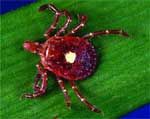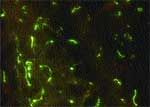Southern tick-associated rash illness: A newly recognized tick-borne disease
Lyme disease caused by Borrelia burgdorferi sensu stricto is endemic in many areas of the United States, including the Northeast, upper Midwest and northern West Coast (Figure 1).
Lyme disease caused by Borrelia burgdorferi sensu stricto is endemic in many areas of the United States, including the Northeast, upper Midwest and northern West Coast (Figure 1). However, in the southeastern and south central United States, classic Lyme disease occurs much less commonly; many medical researchers question the existence of significant endemic Lyme disease transmission in the southern United States. Nonetheless, in the early 1990s, despite mounting epidemiologic evidence that classic Lyme disease was not endemic in the South, some physicians continued to report seeing patients with a clinical syndrome that appeared similar to acute Lyme disease.

Figure 1: Reported cases of lyme disease, united states, 1999
These patients presented with an expanding, circular skin rash (erythema migrans) at the site of a tick bite accompanied by mild illness characterized by generalized fatigue, headache, stiff neck and occasionally fever and other constitutional signs; most cases responded to antibiotic treatment. Although apparently similar, the disease differed from classic Lyme disease in two key ways: (1) when a tick was present or reported, the illness usually followed the bite of a lone star tick, Amblyomma americanum (Photo 1, p. 14), rather than Ixodes sp., the vector of B. burgdorferi, and (2) although acute disease was recognized, chronic disease as is seen in classic Lyme disease was not apparent.
This illness, which is called "southern tick-associated rash illness" (STARI) or "Masters' disease"- in recognition of the physician who first described it - has been attributed to infection with an as-yet-uncultivated spirochete tentatively referred to as Borrelia lonestari (Photo 2, p. 14). Cases consistent with the clinical presentation of STARI have been reported from several southeastern and south central states, including Georgia, Maryland, Missouri, North Carolina and South Carolina. Tests for classic Lyme disease are negative in the majority of patients with STARI. Because B. lonestari has not yet been isolated in culture, PCR amplification of 16S ribosomal DNA and the flagellin gene has been used to identify the presence of the organism in affected individuals. In one report, molecular evidence of B. lonestari, but not B. burgdorferi, was detected in both a patient experiencing the clinical illness and a lone star tick removed from that patient at presentation.

Photo 1: Adult female Amblyomma americanum. The female lone star tick has a single white spot at the base of the scutum that allows it to be readily identified.
Molecular evidence of B. lonestari has been found in wild-caught A. americanum ticks from Alabama, Georgia, New Jersey, Tennessee and Texas, as well as in a tick removed from an individual who had traveled to North Carolina and Maryland before presentation in New York. The organism has also been detected in white-tailed deer from Arkansas, Georgia, North Carolina and South Carolina. Although the complete geographic distribution of B. lonestari has not been established, A. americanum is present throughout much of the eastern and central United States (Figure 2, p. 15), and it is likely that the causative agent of STARI is widely distributed as well.
Natural history of borrelial pathogens in North America
In the northeastern United States, Borrelia burgdorferi sensu stricto, causative agent of classic Lyme disease, is maintained in nature through a cycle involving the white-footed mouse (Peromyscus leucopus) and other rodents as primary reservoir hosts and the black-legged tick, Ixodes scapularis, as vector. The primary role of deer in the natural history of B. burgdorferi is that of serving as a major host for the adults of I. scapularis, allowing vector tick populations to flourish and spread. In the South, larvae and nymphs of Ixodes scapularis are more likely to feed on lizards than mice. Lizards do not support infection with Borrelia burgdorferi, and infection rates in I. scapularis ticks in the South are lower than those in the Northeast.

Photo 2: Borrelia sp. in wild Amblyomma americanum from Georgia.
The natural history of Borrelia lonestari is not completely understood. However, it appears that the organism may be maintained in white-tailed deer as reservoir host and transmitted between deer and to people by the lone star tick, Amblyomma americanum. White-tailed deer are a preferred host for all three-life stages of A. americanum. Although transmission from deer to ticks has not yet been demonstrated with experimental infection studies, larval and nymphal lone star ticks have ample opportunity to become infected while feeding on deer and could then transmit that infection to people when they later feed as nymphs or adults. Lone star ticks also vector Ehrlichia chaffeensis, causative agent of human monocytic ehrlichiosis, and Ehrlichia ewingii, a canine ehrlichiosis agent which has been reported as a cause of disease in immunocompromised people.
Risk to people and domestic animals
People become infected with B. lonestari when fed upon by an infected tick. At present, infection or disease due to B. lonestari has not been reported in domestic animals; however, wide-scale surveys are lacking. Experimental infection studies to evaluate the susceptibility of domestic animals to B. lonestari infection also are lacking. Diagnosis of STARI in people relies on the clinical impression of the physician, as indicated by the presence of the characteristic rash and other clinical signs, and laboratory confirmation via PCR assay of blood or tissue.

Figure 2: Map showing distribution of Amblyomma americanum in North America
The majority of individuals bitten by ticks do not develop any subsequent illness. Antibiotic treatment of individuals with a tick bite but who do not have any evidence of clinical disease is currently not recommended. When a tick is discovered, it should be removed immediately. If an individual bitten by a tick later develops signs consistent with disease (expanding rash, fatigue, fever), then immediate medical attention should be sought and antibiotics administered. Doxycycline is the recommended treatment for STARI.
Recommendations for prevention of STARI are similar to those for preventing other tick-borne diseases. Tick infested areas should be avoided whenever possible. When exposure to tick infested areas cannot be avoided, precautions to prevent tick bites are recommended, including wearing protective clothing and using chemical repellants. Wearing light-colored clothing, performing frequent inspections for recently acquired ticks, and promptly removing ticks whenever they are found will also help prevent transmission of pathogens from ticks to people.

Suggested Reading
Summary
Borrelia lonestari is one of the more recently recognized tick-borne pathogens in North America, and appears to be the etiologic agent responsible for many cases of so-called "southern Lyme." At present, disease due to B. lonestari has not been reported from any domestic animal. However, additional research is needed to determine if dogs or other animals are susceptible to infection or develop disease due to this human pathogen. Dogs and cats in endemic areas are commonly exposed to and infested with A. americanum. Prevention of tick infestations and tick-borne diseases requires consistent use of effective tick preventatives throughout the local transmission season.
Dr. Little is an associate professor of parasitology at the University of Georgia's College of Veterinary Medicine. She is a 1993 graduate of Virginia-Maryland Regional College of Veterinary Medicine, and earned her Ph.D. from the University of Georgia in 1996. Dr. Little's research focuses on ectoparasites and the diseases they transmit.